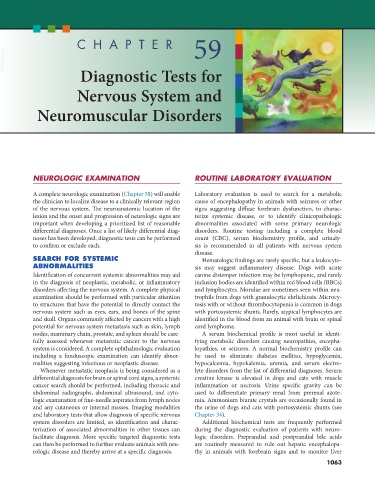Page 1091 - Small Animal Internal Medicine, 6th Edition
P. 1091
CHAPTER 59
VetBooks.ir
Diagnostic Tests for
Nervous System and
Neuromuscular Disorders
NEUROLOGIC EXAMINATION ROUTINE LABORATORY EVALUATION
A complete neurologic examination (Chapter 58) will enable Laboratory evaluation is used to search for a metabolic
the clinician to localize disease to a clinically relevant region cause of encephalopathy in animals with seizures or other
of the nervous system. The neuroanatomic location of the signs suggesting diffuse forebrain dysfunction, to charac-
lesion and the onset and progression of neurologic signs are terize systemic disease, or to identify clinicopathologic
important when developing a prioritized list of reasonable abnormalities associated with some primary neurologic
differential diagnoses. Once a list of likely differential diag- disorders. Routine testing including a complete blood
noses has been developed, diagnostic tests can be performed count (CBC), serum biochemistry profile, and urinaly-
to confirm or exclude each. sis is recommended in all patients with nervous system
disease.
SEARCH FOR SYSTEMIC Hematologic findings are rarely specific, but a leukocyto-
ABNORMALITIES sis may suggest inflammatory disease. Dogs with acute
Identification of concurrent systemic abnormalities may aid canine distemper infection may be lymphopenic, and rarely
in the diagnosis of neoplastic, metabolic, or inflammatory inclusion bodies are identified within red blood cells (RBCs)
disorders affecting the nervous system. A complete physical and lymphocytes. Morulae are sometimes seen within neu-
examination should be performed with particular attention trophils from dogs with granulocytic ehrlichiosis. Microcy-
to structures that have the potential to directly contact the tosis with or without thrombocytopenia is common in dogs
nervous system such as eyes, ears, and bones of the spine with portosystemic shunts. Rarely, atypical lymphocytes are
and skull. Organs commonly affected by cancers with a high identified in the blood from an animal with brain or spinal
potential for nervous system metastasis such as skin, lymph cord lymphoma.
nodes, mammary chain, prostate, and spleen should be care- A serum biochemical profile is most useful in identi-
fully assessed whenever metastatic cancer to the nervous fying metabolic disorders causing neuropathies, encepha-
system is considered. A complete ophthalmologic evaluation lopathies, or seizures. A normal biochemistry profile can
including a funduscopic examination can identify abnor- be used to eliminate diabetes mellitus, hypoglycemia,
malities suggesting infectious or neoplastic disease. hypocalcemia, hypokalemia, uremia, and serum electro-
Whenever metastatic neoplasia is being considered as a lyte disorders from the list of differential diagnoses. Serum
differential diagnosis for brain or spinal cord signs, a systemic creatine kinase is elevated in dogs and cats with muscle
cancer search should be performed, including thoracic and inflammation or necrosis. Urine specific gravity can be
abdominal radiographs, abdominal ultrasound, and cyto- used to differentiate primary renal from prerenal azote-
logic examination of fine-needle aspirates from lymph nodes mia. Ammonium biurate crystals are occasionally found in
and any cutaneous or internal masses. Imaging modalities the urine of dogs and cats with portosystemic shunts (see
and laboratory tests that allow diagnosis of specific nervous Chapter 34).
system disorders are limited, so identification and charac- Additional biochemical tests are frequently performed
terization of associated abnormalities in other tissues can during the diagnostic evaluation of patients with neuro-
facilitate diagnosis. More specific targeted diagnostic tests logic disorders. Preprandial and postprandial bile acids
can then be performed to further evaluate animals with neu- are routinely measured to rule out hepatic encephalopa-
rologic disease and thereby arrive at a specific diagnosis. thy in animals with forebrain signs and to monitor liver
1063

